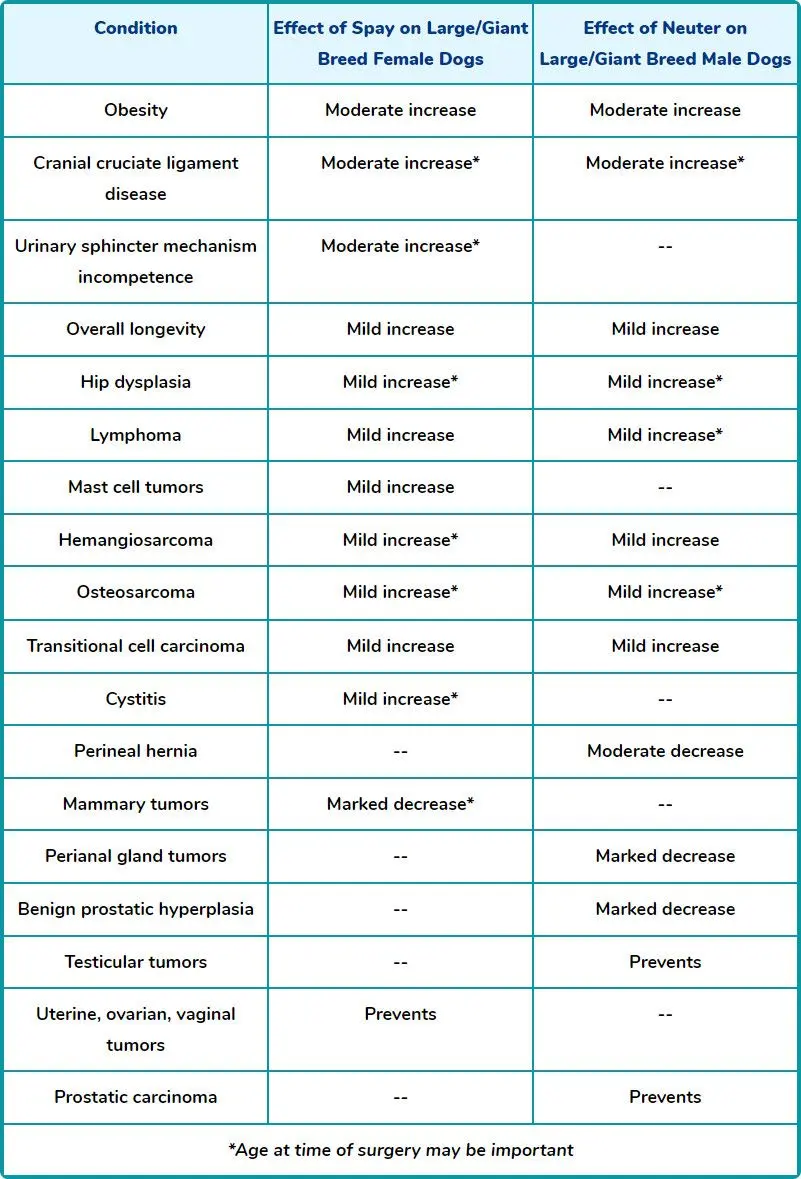Traditional Spay-Neuter Shouldn’t Be the Answer for Every Dog
It's time to consider broader use of alternative sterilization procedures that don’t remove the ovaries or testes, especially for large and giant breed dogs.

STORY AT-A-GLANCE
- Studies show that spaying/neutering (aka desexing) large and giant breed dogs increases the risk for many diseases, including several types of cancer
- While animal health groups are reconsidering their position on automatic spays/neuters, animal welfare groups by necessity remain advocates of early desexing of all shelter pets
- A reasonable compromise may exist in wider use of sterilization procedures that do not remove the ovaries or testes
- For pet parents interested in, for example, an ovary-sparing spay for a female dog or a vasectomy for a male, resources exist but aren’t widely available
- If you decide to spay/neuter your large or giant breed dog, consider waiting until your pet reaches musculoskeletal maturity, and in the case of a female dog, wait until she’s completed her second estrus cycle before scheduling the surgery
A growing body of scientific evidence indicates that spaying and neutering dogs, especially large and giant breeds, and especially at an early age, increases the risk for a wide range of long-term health problems, as outlined in the following table:

Animal Health vs. Animal Welfare
Given the mounting evidence that desexing may not be appropriate in every instance, animal health organizations such as the Morris Animal Foundation and the American Veterinary Medical Association (AVMA)1 have begun to back away from the 1970s-era orthodoxy that called for early spay/neuter for every pet in the U.S.
Back then, both veterinarians and responsible pet owners signed on wholeheartedly to the spay/neuter movement out of a genuine desire to help solve the terrible problem of unwanted pets, tens of millions of which were euthanized in shelters each year.
Today, 31 states and the District of Columbia require that pets adopted from shelters be spayed or neutered before they leave the facility, or that adopters contractually agree to have the procedure performed within a certain timeframe.2 The ASPCA (American Society for the Prevention of Cruelty to Animals) and other animal welfare organizations also advocate early desexing of all companion animals.
To animal welfare groups charged with managing unwanted pets, the current spay/neuter strategy makes sense.
They are necessarily focused on the big picture, and the most effective way to reduce the homeless pet population is to prevent pregnancy. Whereas individual pet owners only have to make sterilization decisions for the dogs in their care, animal welfare organizations must make those decisions on a much larger scale, for the good of the many rather than the few.
How About a Compromise? Sterilization Without Desexing
The reason, in simple terms, that spays/neuters can cause long-term health problems is because these procedures remove the hormone-producing gonads (ovaries or testes). These hormones are used by the body in a multitude of important ways — especially in the case of young animals. Removing the gonads removes dogs’ ability to make these very important naturally occurring substances.
Spays and neuters are desexing procedures (i.e., they remove the animal’s ability to produce sex hormones) used primarily for purposes of sterilization to prevent pregnancy. What many pet owners don’t realize, and veterinarians aren’t taught in vet school, is that dogs can be sterilized without being desexed.
For example, female dogs can undergo a modified spay, also called an ovary-sparing spay or hysterectomy (vs. ovariohysterectomy) that removes the uterus but leaves the ovaries in place, and male dogs can have a vasectomy that preserves the testes. Both procedures result in sterilization, but without removing the gonads and the hormones they produce.
Ovary-Sparing Spay
Because the ovaries are preserved in modified spays, female dogs continue to have estrous cycles (go into heat), but since the uterus has been removed, there’s no bloody discharge. However, the vulva does enlarge. In addition, females continue to secrete pheromones that are attractive to male dogs, and they are receptive to males during their cycles.
It’s recommended that female dogs who’ve undergone ovary-sparing spays not be allowed to mate while in heat, for post-surgery anatomical reasons that may increase the risk of vaginal trauma. You can read more about ovary-sparing spays at the Parsemus Foundation.
Vasectomy
The Parsemus Foundation also provides information on vasectomies for male dogs:
“Vasectomy in dogs is similar to the procedure for men. Each vas deferens (a tube that carries sperm from the testes and epididymis to the urethra during ejaculation) is cut or clamped so that sperm cannot move through. The procedure is completed under anesthesia but is relatively quick and simple. Technical details can be found here. This method of sterilization is accepted by the American Veterinary Medical Association.
There are few health concerns when completing a hormone-sparing sterilization on a male dog, since the only health conditions prevented by neuter are benign prostatic hyperplasia in older dogs (which is treatable by neuter or noninvasive electromagnetic therapy), and testicular cancer (which is also a disease of old age and is treated by castration, which is usually curative).
The dog will be sterile but will still have hormones and be attracted to females in heat. Thus, owners must be willing to keep their dogs from roaming in search of females.”3
Unfortunately, only full spays and neuters are taught in U.S. veterinary schools, so there are relatively few veterinarians across the country who have learned alternative techniques. Please take a minute to email your state veterinary teaching hospital (if you have one) or the AVMA and ask that students be taught alternative techniques while in vet school.
The good news is that the Parsemus Foundation has compiled a state-by-state list of veterinarians who do provide such services at this link.
Be sure to read the information at the top of the page before searching for a vet in your area. Other potential resources include the Facebook Ovary Sparing Spay and Vasectomy Info Group, and the Society of Theriogenology.
My Sterilization Recommendations
My approach is to work with each individual pet parent to make decisions that will provide the most health benefits for the dog. Whenever possible, I prefer to leave dogs intact. However, this approach requires a highly responsible pet guardian who is fully committed to and capable of preventing the dog from mating (unless the owner is a responsible breeder and that's the goal).
It’s important to note that I'm not advocating the adoption of intact shelter animals to people who may or may not be responsible pet owners. Shelter veterinarians don't have the time or resources to build a relationship with every adoptive family, so the animals in their care must be sterilized prior to adoption to prevent more litters of unwanted pets.
My second choice is to sterilize without desexing so the testes or ovaries can continue to produce hormones essential for the dog's health and well-being.
Rarely, older, intact male dogs develop moderate to severe benign prostatic hyperplasia (an enlarged prostate) that may be improved with conventional neutering. Generally speaking, mature intact dogs have had the benefit of a lifetime of sex hormone production, so the endocrine imbalances we see with spayed or neutered puppies don't occur when dogs are desexed in their later years.
Unfortunately, as I mentioned earlier, veterinary schools in the U.S. only teach full spays and neuters, so unless your own vet has obtained additional training in sterilization techniques that spare the ovaries or testicles (which is unlikely), you may have only one option available to sterilize your pet.
In that case, my suggestion would be to wait until your dog has reached full musculoskeletal maturity, and if you have a female, I’d also wait until she’s completed her second estrus cycle before scheduling the surgery.
Sources and References
- 1 The Atlantic, July 22, 2019
- 2 AVMA.org, Updated June 2019
- 3 Parsemus Foundation
Today's Pet Video:
Frustrated Capuchin Monkey Tries to Crack a Nut
BBC/PBS’s Spy in the Wild focuses on a capuchin monkey trying to break open a nut with a large rock. Trouble is, he’s used the wrong surface and has to rethink his method.











